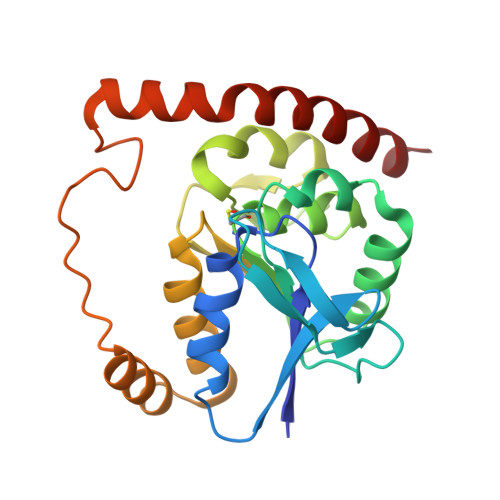Evolution of New Enzymatic Function by Structural Modulation of Cysteine Reactivity in Pseudomonas fluorescens Isocyanide Hydratase.
Lakshminarasimhan, M., Madzelan, P., Nan, R., Milkovic, N.M., Wilson, M.A.(2010) J Biol Chem 285: 29651-29661
- PubMed: 20630867
- DOI: https://doi.org/10.1074/jbc.M110.147934
- Primary Citation of Related Structures:
3NON, 3NOO, 3NOQ, 3NOR, 3NOV - PubMed Abstract:
Isocyanide (formerly isonitrile) hydratase (EC 4.2.1.103) is an enzyme of the DJ-1 superfamily that hydrates isocyanides to yield the corresponding N-formamide. In order to understand the structural basis for isocyanide hydratase (ICH) catalysis, we determined the crystal structures of wild-type and several site-directed mutants of Pseudomonas fluorescens ICH at resolutions ranging from 1.0 to 1.9 Å. We also developed a simple UV-visible spectrophotometric assay for ICH activity using 2-naphthyl isocyanide as a substrate. ICH contains a highly conserved cysteine residue (Cys(101)) that is required for catalysis and interacts with Asp(17), Thr(102), and an ordered water molecule in the active site. Asp(17) has carboxylic acid bond lengths that are consistent with protonation, and we propose that it activates the ordered water molecule to hydrate organic isocyanides. In contrast to Cys(101) and Asp(17), Thr(102) is tolerant of mutagenesis, and the T102V mutation results in a substrate-inhibited enzyme. Although ICH is similar to human DJ-1 (1.6 Å C-α root mean square deviation), structural differences in the vicinity of Cys(101) disfavor the facile oxidation of this residue that is functionally important in human DJ-1 but would be detrimental to ICH activity. The ICH active site region also exhibits surprising conformational plasticity and samples two distinct conformations in the crystal. ICH represents a previously uncharacterized clade of the DJ-1 superfamily that possesses a novel enzymatic activity, demonstrating that the DJ-1 core fold can evolve diverse functions by subtle modulation of the environment of a conserved, reactive cysteine residue.
Organizational Affiliation:
Department of Biochemistry and Redox Biology Center, University of Nebraska, Lincoln, Nebraska 68588-0664, USA.
















